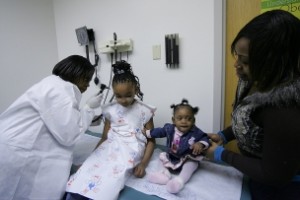By Stephanie Snyder, California Watch
 Low-income children in rural California are in danger of losing their doctors and health care plans under Gov. Jerry Brown's budget proposal, state lawmakers, doctors and health advocates say.
Low-income children in rural California are in danger of losing their doctors and health care plans under Gov. Jerry Brown's budget proposal, state lawmakers, doctors and health advocates say.
The governor is proposing to transfer nearly 900,000 children enrolled in Healthy Families, the state’s Children’s Health Insurance Program, to Medi-Cal – a program aimed at serving the state’s poorest families, seniors and disabled residents.
One major concern is that many doctors who accept children in the Healthy Families program do not accept Medi-Cal, because of Medi-Cal’s lower reimbursement rates.
While combining the two programs might be a painless transition for children in urban areas with doctors who typically provide care to both Healthy Families and Medi-Cal patients, the transfer could make it tough for families in rural areas to find doctors who accept Medi-Cal.
“In the more rural areas or outlying areas, there would be quite a loss or quite a strain,” said Stuart Cohen, a San Diego pediatrician and California chairman-elect for the American Academy of Pediatrics. “Access to care would be a huge issue.”
And there would not be much incentive for rural doctors at full capacity to continue caring for their Healthy Families children if they do not already serve Medi-Cal patients, Cohen said.
The governor’s proposal requires doctors to accept Medi-Cal’s monthly reimbursement – an average cut of nearly 20 percent over Healthy Families rates. Doctors currently receive a monthly average of $103 per patient in Healthy Families, but Medi-Cal pays $84 on average per patient.
A survey referenced by the Legislative Analyst’s Office asked pediatricians who now provide care to Healthy Families patients, but not Medi-Cal patients, if they would be willing to make the switch. The February report said 29 percent would not accept Medi-Cal and 46 percent were not sure.
Anthony Wright, executive director of Health Access California, an advocacy group, said there likely would be a disruption of care for Healthy Families patients in rural areas when their doctors face the decision of whether they can accept a smaller payment.
“People have doctors, they have networks of physicians, children are getting care as we speak,” Wright said. “Will they have access to the same physicians if they’re in the middle of treatment?”
Assemblyman Bill Monning, D-Monterey, said the health department addressed questions about access to care during last week's budget subcommittee meetings.
“We already face shortages in rural areas of providers – not only in primary care, but specialty services and providers,” says Monning, who serves on the health subcommittee. “We have to be very cautious that we don’t maneuver ourselves out of access for families. … You can’t move children who are currently in Healthy Families to an environment where there aren’t providers that accept Medi-Cal.”
“There’s no program that isn’t facing cuts or reductions and yet when you look in the area of health and human services we have to be mindful of the imminent consequences,” Monning continued. “We understand the need to achieve savings, but at what cost?”
Legislators hope to find some middle ground on the issue of children's health care and last week, the Senate budget subcommittee on health voted to support an alternative plan. The Assembly budget subcommittee is expected to follow suit, Monning said.
Opponents to the governor’s proposal say the state should make the transition more slowly, instead of all it once. They suggest first transferring to Medi-Cal only the 186,000 Healthy Families patients from families earning less than 133 percent of the federal poverty level.
The proposal to move all 878,000 patients enrolled in Healthy Families to Medi-Cal creates several administrative concerns by transitioning too many kids too quickly, said Cohen, the San Diego pediatrician.
“We don’t think that the state has the capacity to smoothly transfer all of the patients at once,” Cohen said. “The only one that’s not in agreement is the governor’s office.”
But there would be some benefits to combining the programs, he said.
Medi-Cal patients are treated with a “richer benefits plan,” Cohen said. Unlike the Healthy Families program, children would have greater access to free vaccinations and speech and developmental treatment, Cohen said.
Access to care is a concern with such a large potential transition of patients, said Wright, of Health Access. But transitioning a smaller number of children to Medi-Cal would help “work out some kinks.”